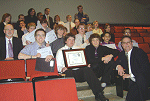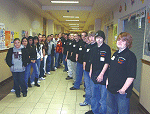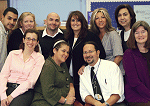THE Journal's 2008 Innovators :: 4
Mark Rhoades and Yvonne Johnson
Lewis and Clark High School (WA)

Lewis and Clark High
students help launch
TEConnections at a
lower-income
high school.
Shortly after Mark Rhoades joined Lewis and Clark High
School in 2004 as a computer teacher, Yvonne Johnson, a
career and technical education support specialist, approached
him with the idea of turning the school's surplus computers
taking up space in a warehouse into a service project for
students and the community. Rhoades was interested: "I was
looking to give my students something hands-on to do."
The two of them took the idea to the Washington State
Department of Social and Health Services, which could funnel
the machines to the low-income families that most needed
them. Four years later, TEConnections, the after-school program that grew out
of Rhoades and Johnson's collaboration, has distributed
computers to 1,000 families in the eastern Washington area.
The only stipulations are that the recipients must have a K-12
student at home and own no other computer.
"A lot of statistical evidence supports the idea that if you
can get technology into the hands of students and let them
access it at home, you can improve their performance in
school," says Rhoades.

Rhoades (front right) with his
students after
they were
honored locally as Best
Community Service Group.
His own students benefit by fixing the equipment and delivering
it. To prepare the computers for distribution, students
learn how to wipe hard drives, blow out dust, add RAM, and
test the system and components. "Once the hardware is determined
to be in good working condition, they build one system
from scratch and make a clone image of that system," says
Rhoades. "Then they transfer that image to other machines."
Families receive a computer running Microsoft's Windows
XP and Office 2003 and peripherals. The program is funded
by a three-year grant from the federal initiative Learn and
Serve America. According to Rhoades,
the cost to the program is about $25 per system delivered.
Participating families can receive discounted internet service
from a local provider.
Every third Wednesday during the school year, a group
of 15 of the recipient families meet at Lewis and Clark for
one-on-one training given by the same students who refurbish
the machines. Lessons cover basics such as how to set up the
computer and save a file. "There's a lot of interaction,"
Rhoades says. "Students who are perhaps not as outspoken
have learned how to communicate with people. Once they
start getting their self-confidence and self-esteem, they start
improving performance in other academic areas. By being
involved, they start to see that a career in IT might be something
that's good for them."
Celine Azoulay-Lewin
New York City Department of Education
 Celine Azoulay-Lewin, the New York City Department of
Education's borough instructional technology director for Staten
Island/South Brooklyn, remembers her aha! moment during her
district's deployment of gaming environments for teaching math.
Celine Azoulay-Lewin, the New York City Department of
Education's borough instructional technology director for Staten
Island/South Brooklyn, remembers her aha! moment during her
district's deployment of gaming environments for teaching math.
"There was one student who was a good kid," she says. "Just
quiet. Didn't go above and beyond his schoolwork." But playing
the math games inspired him. Azoulay-Lewin says he created a
playbook in which he'd write out math concepts and formulas so
he could understand them better, just so he could gain more
points and advance in the game.
That enthusiasm for Tabula Digita's pre-algebra and algebra games, Evolver and Dimenxian,
respectively, is common at the four schools where the district
introduced them in September 2006, after a long search by
Azoulay-Lewin for something new to try in middle school
math classes "that nobody else was doing," she says. She
waited through several iterations of the game before feeling
they merited piloting.

Students use gaming to learn
pre-algebra and algebra.
Eleven middle school math teachers spent a day learning the
concepts of the games and how to incorporate them into a lesson,
then played a couple of "missions." Teachers now use the games
for instructional purposes two or three days a week.
Evolver and Dimenxian are modeled after commercial
products like Microsoft's Halo. The two math
games have similar characteristics and features: Each player has
an avatar charged with a mission-- say, to find out why an
island-based government research facility has been closed and
quarantined. As the avatar moves through layers of the game,
music pounding away, equations come up that need solving.
Correct answers and game prowess add to the player's points.
There are also timed missions, where
players, for instance, have to convert
fractions to decimals and decimals to
percents.
"Principals were awed at not only
the level of student engagement, but
also the motivation of students to want
to learn math," Azoulay-Lewin says.
By January 2007, three additional
schools had been added to the pilot, and
by the following September the deployment went citywide
among middle schools.

Azoulay-Lewin (center) and
her staff at the New York
City Department of Education.
The key to playing the math games successfully is knowing
the subject matter. Correctly guessing the answer to a problem
is worth far less than demonstrating you can work out the
proper formula. "The point spread is so varied that if you're
guessing, you're going to lose," Azoulay-Lewin says.
The students not only play in class, but they can install a
home version and take part in online competitions against
their peers. Tabula Digita has sponsored competitions that
bring together students from multiple cities or from within the
same district. In fact, says Azoulay-Lewin, the competition
that took place last December among schools around New
York City was the culminating moment for her in the success
of the project. The first, second, and third prizes went to teams
from her schools.
Vincent Davila
Jesuit High School (FL)
 As the assistant director of technology at Tampa's Jesuit
High School, Vincent Davila is no stranger to lightning.
After all, according to the National Weather Service, the
corridor running from Tampa Bay on the Gulf of Mexico to
Titusville on the eastern side of Florda sees more lightning
than anywhere else in the country.
As the assistant director of technology at Tampa's Jesuit
High School, Vincent Davila is no stranger to lightning.
After all, according to the National Weather Service, the
corridor running from Tampa Bay on the Gulf of Mexico to
Titusville on the eastern side of Florda sees more lightning
than anywhere else in the country.
Still, it took a support technician's replacing of a motherboard
in a new Siemens MXL fire
alarm system to show Davila it was a good thing that the
school was upgrading to fiber optics from copper. The tech
had just replaced the board, which had been fried in a lightning
strike, and was in the process of testing the new board
when a second lightning strike took it out.
"That happened probably about 15 or 20 minutes after the
board was installed," says Davila.
Jesuit High has 12 separate buildings. Originally, the phones,
fire alarm system, public address system, and security and energy
management systems all ran on copper wire laid in a fourpipe
conduit system underground in a star formation. When
lightning struck anywhere on campus, inevitably some piece of
equipment running on the copper would stop working. It didn't
help that the school was built on a wetlands-like pasture. "The
groundwater is very saturated," says Davila. "Sixty-five to 70
percent of the year, those [lines] are actually underwater."
About eight years ago, Tampa-based technology firm Mission
Critical Solutions, which is run by a
Jesuit High alumnus, Gilbert Gonzalez, helped the school
fund and install 62.5-micron fiber optics through the conduit
system. The technology and facilities teams built a network
backbone on half of that and converted the energy management
system to it as well. "The good thing about moving everything
to fiber optics," says Davila, "is that since it's glass, lightning
strikes don't do anything to it."
Eventually, as part of a decision to deploy IP-based video
capability on campus, the fiber network was expanded with
50-micron fiber. The school upgraded its network switches
to accommodate the video and moved its network to the new
fiber. The fire alarm system, whose hardware had been
replaced by Siemens the year
earlier, was put on the older
62.5-micron fiber. That required
working with the vendor to create
converter boxes that would allow
the alarms to work on fiber
instead of copper.
"It's amazing how many things go
over fiber," Davila says, debunking
the myth that you need to replace
your equipment to become IP-based.
For example, fiber converters
inside each school building convert
the fire alarm's signal from copper
to fiber and back again as it runs between the buildings.
The next project is to implement a voice over IP phone
system. Once that's in-- probably next summer-- the school
will be able to rid itself of its last remaining bit of underground
copper wire. "Moving to fiber optics is not as scary as
it might have been in the past," Davila says, pointing out that
with equipment such as the fire alarm, bell, and PA systems,
it's certainly less frightening than the life-threatening reality
of a lightning strike.
This article originally appeared in the 12/01/2008 issue of THE Journal.